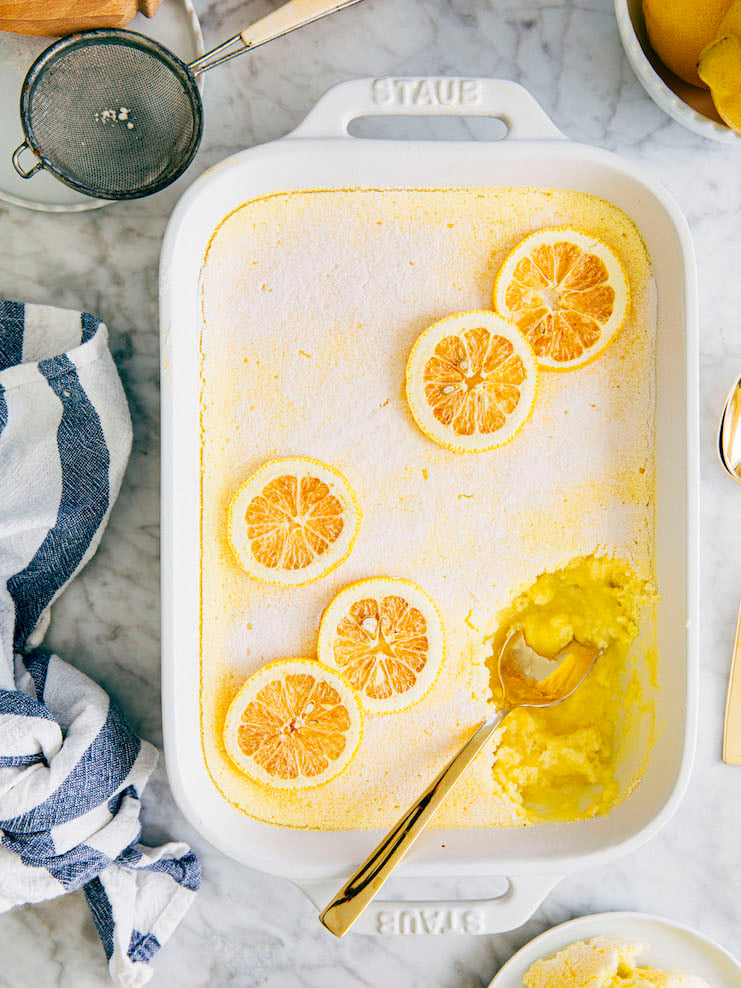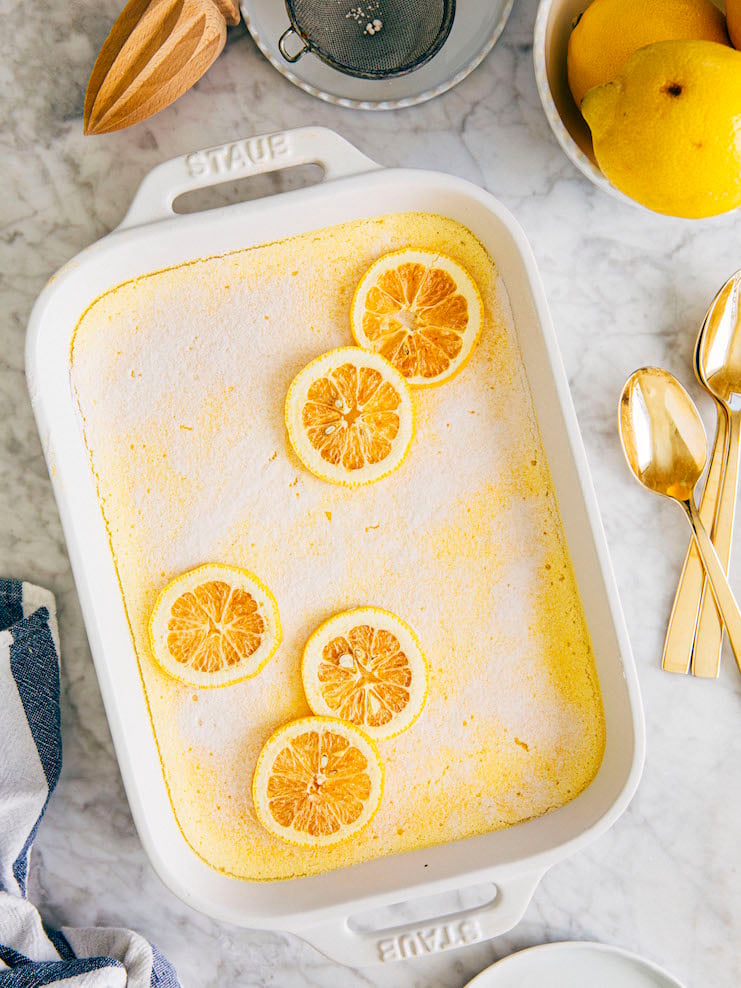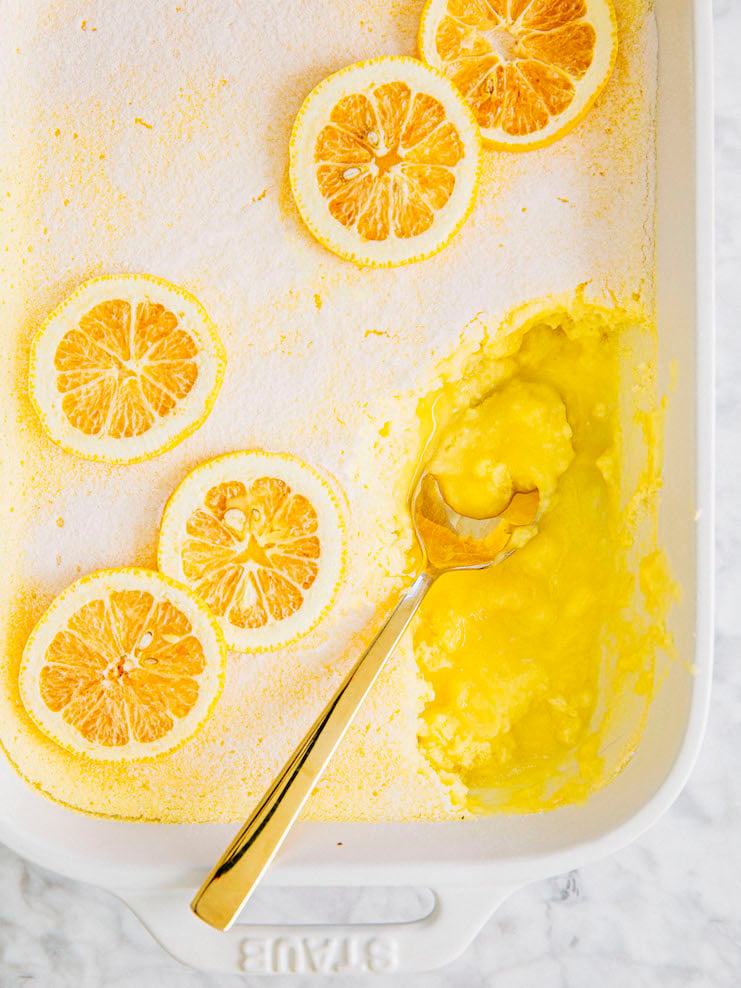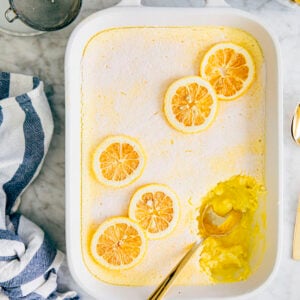
About This Lemon Pudding Cake
This lemon pudding cake recipe is made with two layers: light and airy soufflé-like sponge cake sits on top of luscious and tangy lemon curd.
But don’t worry!
There’s no need to make two different recipes for both the cake and the curd. Both are made from the same batter, minimizing the amount of work you need to do for the recipe. Cool, right?
Why You Should Make The Recipe
This lemon pudding cake is a modern twist on an old-fashioned recipe.
Lemon pudding cakes first became popular in the United States thanks to the Boston Cooking-School Cook Book by Fannie Farmer. (Coincidentally, this was also the first cookbook to provide quantities in measuring cups!) However, the original recipe can be traced as far back to 17th century England, where it was served as a popular dessert.
Despite its long history, the recipe remains suited for modern tastes. I mean, what’s not to like with a light-and-airy sponge cake served with warm lemon curd? That being said, I did update the recipe to incorporate some more “modern” techniques I’ve learned from my years of baking: rubbing fresh lemon zest into the sugar makes a more flavorful cake, and using a whisk to help fold in ingredients makes your life easier. Learn more in the recipe!
The recipe comes together quickly and easily.
Despite the fact that lemon pudding cake has two distinct components (sponge cake and lemon curd, duh), it’s made from just one batter!
How?
The recipe instructs you to place the cake pan full of batter in a roasting pan halfway full of water. The half of the pan submerged in the water bakes into the lemon curd, whereas the half of the pan above it bakes into the light and airy sponge cake. How cool is that?
So really, think of this lemon pudding cake as a 2-for-1 type of recipe. You get two “different” desserts, all for the work of one! All things considered, the recipe comes together quickly and easily.
The cake stores well.
Because of its lemon curd layer, this lemon pudding cake stays fresh and moist for days! The best part? Although it’s wonderful fresh and warm from the oven, it’s also delicious served chilled after a day in the refrigerator. I feel like its flavors intensify and it becomes more lemony!

Ingredient and Substitutions
Now that I’ve convinced you to make this light and airy lemon pudding cake, here’s everything you need to make the recipe:
Shopping List for Lemon Pudding Cake Recipe
- granulated sugar
- large lemons
- buttermilk
- all-purpose flour
- unsalted butter
- kosher salt
- large eggs
And let’s talk about some key ingredients and potential substitutions:
Common Ingredient Substitutions For The Recipe
- Lemons. In a pinch, you can use store-bought lemon juice without any added sugars or sweeteners. But your lemon pudding cake won’t taste as fresh as mine!
- Buttermilk. No buttermilk? No problem. Substitute with whole milk instead! Just note that your lemon pudding cake won’t be as tangy.
- All-Purpose Flour. Substitute the all-purpose flour with your favorite 1-1 Gluten Free All Purpose Flour (I like the ones by Bob’s Red Mill and King Arthur Baking Company) to make the cake gluten-free!

How To Make Lemon Pudding Cake
Here are the basic steps to make lemon pudding cake from scratch:
- Measure out the ingredients for the recipe and boil the water needed for baking the cake in a water bath. (Prep Time: 10 minutes)
- Make the cake batter. (Work Time: 15 minutes)
- Bake the cake. (Bake Time: 40 minutes)
Best Recipe Tips
- It’s important to use ceramic or glass baking equipment whenever you bake with lemons. Why? Lemon juice reacts with metal, giving the dessert a metallic taste! If possible, use a glass bowl to mix the batter, and a ceramic or glass baking dish to bake the cake.
- Want to turn this into an almost one bowl recipe? Easy. Melt the butter in the bowl that you’re planning on making the batter in. Then, add the rest of the ingredients (including the lemon zest and sugar—there’s no need to rub the two together beforehand if you’re going the almost-one-bowl route, but it WILL make your cake more flavorful).
- Folding is one of my least favorite baking techniques. I feel like I always end up with some stubborn lumps that refuse to fold into the mixture despite a solid 5 to 10 minutes of work!
That being said, I did learn an awesome trick from a Japanese pastry YouTube tutorial. If you find yourself in a similar situation (in which you’ve folded the mixture hella, but still have a handful of stubborn lumps), use a whisk.
Slowly, slowly, slowly whisk the mixture, holding the whisk at the top of the bowl and slowly working your way downwards as you whisk. This will help incorporate everything together. But be careful not to go too quickly, or overdo it! You might accidentally deflate your batter.
Get the Recipe: Lemon Pudding Cake Recipe
Ingredients
- 1 cup (7 ounces or 198 grams) granulated sugar
- fresh lemon zest from 3 large lemons
- ⅓ cup (2.65 ounces or 75 grams) freshly squeezed and strained lemon juice (from about 3 large lemons)
- 1 ½ cups (12 ounces or 340 grams) buttermilk
- ½ cup (2.25 ounces or 64 ounces) all-purpose flour
- 2 Tablespoons 2 Tablespoons (1 ounce or 28 grams) unsalted butter, melted and cooled slightly, plus more for pan
- ½ teaspoon kosher salt
- 4 large eggs, separated into whites and yolks
Equipment
- 8-inch square pan, preferably glass or ceramic
- turkey roasting pan OR a baking pan big enough to hold an 8-inch square pan
Instructions
- Prep the oven, pan, and water bath. Position a rack in the center of the oven and preheat the oven to 350°F. Lightly butter an 8 x 8-inch ceramic or glass square cake pan. Bring a large kettle of water (enough to fill the roasting pan with 1 to 2 inches of water) to a boil.
- Make the lemon sugar. In a large glass bowl, combine the sugar and lemon zest. Use your fingers to rub the zest into the sugar—this will infuse the sugar with oils from the zest.
- Mix in the rest of the ingredients (except the egg whites). Add the lemon juice, buttermilk, flour, butter, salt, and egg yolks and mix to combine. It’s okay if the mixture looks lumpy—that’s totally normal, I promise!
- Whisk the egg whites. In the bowl of a stand mixer fitted with the whisk attachment, whisk the egg whites. Whisk on low speed until foamy, 1 minute, then turn the mixer up to medium-high. Whisk until stiff peaks form, 3 to 4 minutes.
- Fold the egg whites into the rest of the ingredients. Use a wooden spoon or ladle to carefully scoop the egg whites into the medium bowl with the rest of the ingredients—be careful not to deflate them! Use a rubber spatula to fold in the ingredients until just combined.
- Assemble the cake for baking. Pour the batter into the prepared cake pan and use an offset spatula to smooth the top. Set the cake pan inside the roasting pan. Pour the boiled water into the pan until it reaches halfway up the sides of the cake pan.
- Bake the cake. Bake for 40 to 45 minutes, or until the top of the cake bounces back when gently pressed. The cake should wobble ever so slightly when pulled out of the oven.
- Serve and store. Serve warm, or at room temperature. The lemon pudding cake will keep, covered loosely in plastic wrap, in the refrigerator for up to 3 days. To reserve, rewarm in the microwave or eat chilled.




